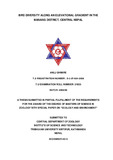Please use this identifier to cite or link to this item:
https://elibrary.tucl.edu.np/handle/123456789/3265| Title: | BIRD DIVERSITY ALONG AN ELEVATIONAL GRADIENT IN THE MANANG DISTRICT, CENTRAL NEPAL |
| Authors: | GHIMIRE, ANUJ |
| Keywords: | biodiversity;MANANG DISTRICT;Birds |
| Issue Date: | Dec-2015 |
| Abstract: | Species richness of birds along an elevational gradient in Himalayan region including Nepal is less explored till the present. Studying diversity and community structure of birds will help biodiversity conservation. The present study explores the patterns of diversity and distribution patterns of avian fauna in Manang region, central Nepal and also explores the factors that affect the diversity and distribution. In addition, I also tested if there is any validity of Bergmann's rule for birds in Manang region. To fulfill the above mentioned objectives, data on the distribution of bird communities were collected along an elevational gradient in two valleys in Manang, central Nepal between August and October 2014. In addition to this, I also collected data on a range of environmental variables at all sites in order to determine their association with bird diversity and species composition of bird communities. Point count method in 19 different localities each with an approximate difference of 200 meters above sea level were conducted. At each plot, birds were recorded within a circle of 50 meters radius from a fixed point in a center. Different environmental variables, such as slopes, shrubs, agricultural fields were also documented to see the affect distribution of bird species were recorded at each sampling point. To find out the determinants of bird species richness, generalized linear model (GLM) with Poisson distribution and log link function was used and multivariate analysis (Canonical Correspondence Analysis, CCA) was used to show the relationship between bird species composition and environmental variables. I found that there were 82 species of birds in total of 19 different plots, comprising of 24 families. The largest numbers of birds were represented from Muscicapidae followed by Corvidae, Fringillidae and Phylloscopidae. The highest number of birds were common (n=53) followed by scarce (n=16), frequent (n=10) and rare. Bird species richness significantly decreased with increasing elevations in the overall dataset in Manang district. Species richness of all the birds in Manang increased with the presence of forest and shrubs whereas it decreases with the increase of slope of the land. Surprisingly, there were more species of birds near the settlements in Manang. As species richness, bird composition was influenced by elevation and also other factors such as steepness of the land, presence of agricultural fields or shrubby area. It was found that the body size of the birds increased with increasing elevation (p=0.0007; r2=0.0657), meaning that the Bergmann's rule was true for birds from Manang. |
| URI: | http://elibrary.tucl.edu.np/handle/123456789/3265 |
| Appears in Collections: | English |
Files in This Item:
| File | Description | Size | Format | |
|---|---|---|---|---|
| Thesis print final Anuj .pdf | 1.22 MB | Adobe PDF |  View/Open |
Items in DSpace are protected by copyright, with all rights reserved, unless otherwise indicated.
